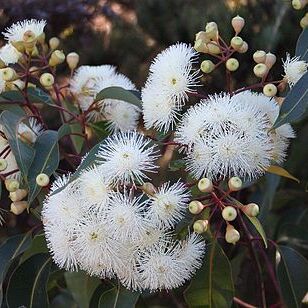Usually a tree to 40 m tall, or mallee-like to 5 m on poor sites. Forming a lignotuber. Bark rough to the small branches, tessellated, brown to grey-brown. Branchlets lacking oil glands in the pith. Juvenile growth (coppice or field seedlings to 50 cm): stems round in cross-section, hairy or scabrid to ca node 8; juvenile leaves petiolate, broadly lanceolate to lanceolate, bases peltate on first leaves then round to tapering, alternate, 4.5–24 cm long, 3.5–9 cm wide, margins usually entire, rarely irregular, glossy green. Leaves scabrib, becoming smooth after ca 4–5 nodes. Adult leaves alternate, petioles 1.5–3.5 cm long; blade ovate to broadly lanceolate to lanceolate, 7–19 cm long, 2–5.5 cm wide, flat to slightly undulate, glossy to slightly glossy, discolorous being darker green above, paler below, base tapering to the petiole, margin entire, apex acute, side-veins penniveined, reticulation dense to very dense, intramarginal vein present but close to the leaf margin, oil glands very numerous and island, usually one oil gland per areole. Inflorescence terminal compound, peduncles 1.5–3.5 cm long, buds 7 per umbel, pedicels 0.6–3.7 cm long. Mature buds pyriform, 0.6–1.4 cm long, 0.6–1 cm wide, surface smooth (not scurfy), scar absent (both opercula shed together at flowering), operculum flattened, stamens inflexed, anthers oblong, versatile, dorsifixed, dehiscing by longitudinal slits, style long and straight, stigma papillate (mop-like), locules commonly 3 (rarely 4), ovules not in regular rows. Flowers white, rarely pink. Fruit pedicellate (pedicels 0.7–4 cm long), urceolate, 1.9–4.4(5) cm long, 1.8–4 cm wide, disc vertically descending, valves 3 (rarely 4), deeply enclosed. Seeds dull to semi-glossy, black, 10–15 mm long, cymbiform (boat-shaped), wing absent, hilum ventral. Cultivated seedlings (measured at node 10): cotyledons reniform; stems round in cross-section, scabrid to ca node 10; leaves petiolate, opposite for the first 3 nodes then alternate, broadly lanceolate to ovate, 7–12 cm long, 3.3–6 cm wide, dull to slightly glossy green, base peltate to ca the 10 th node then rounded or tapering to the petiole, lamina scabrid till ca node 8.
More
Tree to 40 m, occasionally to 60 m. Bark tessellated throughout, grey or grey-brown. Juvenile leaves alternate, petiolate, peltate, ovate, strongly discolorous. Adult leaves alternate, ovate to broadly lanceolate, acuminate, thick; lamina 9–14 cm long, 2.5–4 cm wide, shining, dark green, strongly discolorous; lateral veins fine, at 50°–70°; intramarginal vein very close to margin; petiole flattened, 15–20 mm long. Umbels 3–7-flowered; peduncle terete or angular, 15–35 mm long; pedicels 10–30 mm long. Buds clavate; operculum flattened-hemispherical, apiculate, 2–4 mm long, 7–8 mm wide; hypanthium urceolate, 5–10 mm long, 7–10 mm wide. Fruits urceolate, usually contracted at orifice, 3–5 cm long, 2.8–4 cm wide. Seeds wingless, black.


